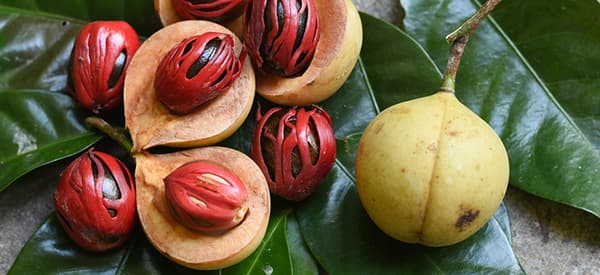
Nutmeg
Nutmeg (Myristica fragrans) is an evergreen tree that produces two different exotic spices – nutmeg and mace. The pit of the nutmeg tree is a versatile spice for many sweet and savory recipes. Mace is the web that covers the seed and is used differently than the pit. It has a slightly intense flavor and is used similarly to black pepper. The seed is the popular and readily available spice since the tree yields it ten times more than mace. It is also not a wonder why mace is quite expensive than nutmeg.
Generally, when a recipe calls for nutmeg, it means the whole seed or the ground form. Aside from being an indispensable spice in holiday eggnog, it is also used as a homeopathic remedy. It is a source of antioxidants that can slow down aging and prevent heart diseases. It is also rich in fiber and a source of essential vitamins. However, nutmeg has a potent effect that excessive intake can induce hallucination and is used by some to create a “high” effect.
According to The Taste of Conquest book by Michael Krondl, nutmeg has one of the saddest stories in history. The spice is exotic and powerful and it was favored among the wealthy. When the European expedition reached Banda Island in Indonesia, the Dutch troops massacred the locals attempting to monopolize the trade. The spice trade propels the spreading of nutmeg in Europe and the United States. It was used as incense and is one of the most expensive commercial spices in the Western world.
Where Can You Find Nutmeg?
Nutmeg is a tropical tree indigenous to the Banda Islands or Spice Islands of Indonesia. This evergreen tree is also cultivated in West Indies, New Guinea, and South Africa. Presently, Guatemala, India, and Indonesia are among the top global producers.
⇒ The Complete Map of Edible Plants: Find Out What You Have in Your Area!
How To Identify Nutmeg
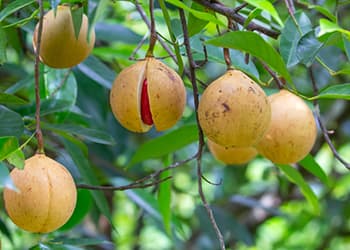
As we know, it is either in the form of a wrinkled nut or ground spice. These nuts came from a tree with whorled branches that flourish in a natural conical shape. It bears a fruit that resembles an apricot called the nutmeg apple. It is often utilized as jams or candies, while the pit commercially lands in the spice aisles of supermarkets.
Leaves. The evergreen leaves of the nutmeg tree are smooth and shiny. They are simple and lanced-shaped arranged alternately on the branches. Each leaf is about 5 to 15 cm long with a dark green glossy surface and a lighter-colored underside.
Flowers. Nutmeg tree flowers are pale yellow or white and arranged either in clusters or solitary in a tree. The clustered flowers are male, while females are either alone or in a group of three. The fruits are dioecious, meaning they do not have the same male and female flowers in each tree. They pollinate through fauna, birds, or manual pollination by farmers.
Roots. Nutmeg has a shallow root system with one taproot and a web of shallow underground roots. Underground, it’s roots can spread even wider than its branches above.
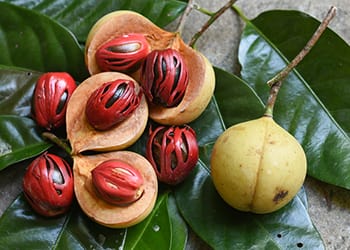
Fruits
The fruit is a yellow and fleshy bell-like seeded drupe about 6 to 9 cm long and almost as broad.
Seeds. The seeds are initially white and turn brown upon air exposure. It has a bright red net-like covering, which is where the mace comes from. The outside of the pit has wrinkles and a dark brown scar at the end.
Stem. Nutmeg can grow to up to 66 ft (20 m) with a single-stemmed grey-brown trunk. Mature trees have dark-brown to greyish bark that is rough with fissures. The trunk diameter varies, but mature ones can reach a size of about 60 to 80 cm. The branches spread laterally in a whorled spiral arrangement.
⇒ Plant Identification Guide – 400 Wild Plants That You Can Forage For
Myristica fragrans is still being studied for breeding varieties with a higher yield. However, the Spices Board in Kerala still prefers promoting the older variety of nutmeg. Some of the new varieties available are: Konkan Swad, Konkan Sugandha, Vishwashree.
How To Grow Nutmeg
Nutmeg propagates through its seed or stem cuttings or grafting the budded plant. They prefer well-drained, fertile loamy, and acidic soil. As a tropical tree, it will thrive under the full sun and grow in USDA zones 10 to 11. Its root is shallow and you may need to choose a site away from the gusty wind.
You may germinate it by separating the seed from its aril. To do this, sterilize a knife with rubbing alcohol and cut through the base of the aril joining the nut. Be careful not to damage the seed while separating them. You may dry the aril thoroughly for about 15 days and grind it into mace.
Meanwhile, soak the nutmeg seed in clean water for 24 hours. Sow it in a pot with well-draining potting soil about 1-inch deep. Water the pot, allow it to drain, and let it stand in a warm area with a temperature between 77 to 86°F.
Moisten the plant regularly but avoid letting it go soggy. It may take the seed about 1 to 2 months to germinate. Transfer the seedlings in a polybag when the seedling is already mature. Space the seedlings 10 meters apart when transplanting.
⇒ Stop Spending Money At The Pharmacy By Growing These 10 Plants
Fruiting a Nutmeg
This fruit is dioecious, where the plant may either be male or female and will not fertilize itself. Thus, to increase its success planting multiple nutmegs is necessary. You will know the sex of the plant until it starts flowering at about 5 to 8 years.
Growing a nutmeg is a slow process that requires patience. It will peak its yield at about 25 years old but will continue fruiting for the next 60 years or more.
Nutmeg Plant Care and Maintenance
Growing such tree can be tricky and lengthy, but it is always worth waiting. It can also get frustrating if you happen to grow a male tree. But expert farmers have different approaches to converting a male into a female nutmeg, like grafting and Vitro propagation.
In the meantime, here are some of the ways to keep the fruit healthy as it grows:
- Semi-shade to full sun

- Moderate water
- Deep loamy sand with rich organic matter
- Soil pH between 5.5 to 7.5
- Shelter from the wind
- 5 to 7 days of irrigation during summer
- Mulching around the tree but away from the trunk to avoid pests
How To Harvest Nutmeg
After a minimum of five years, some nutmeg may already start to bloom. The fruit ripens after 6 to 9 months. The fruits are ready for harvest once it split and expose the aril. They are harvested from the tree using a long pole with an attached blade and basket to catch the fruits.
The pits of nutmeg are then separated from the aril. They are dried under the sun or in electric dryers under 104°F (40°C). The dried fruit is either ground, stored, or processed for commercial use.
Ground nutmeg may last for up to six months before losing its flavor. But the whole fruit can remain fresh for up to 12 months in an airtight container.
Nutmeg Benefits And Natural Remedies Made From It
Traditionally, it is used for alleviating digestive and respiratory problems. In India, the locals use this fruit as a tonic after childbirth.
Nutmeg is an excellent brain tonic that’s why it is widely popular during ancient times. When used moderately, it can relieve exhaustion, sleep problems, and other mental health issues. It can also improve concentration to help the user improve their mental performance. It can help control spasm with its sedative and tranquilizing effect.
⇒ A Before-Bed Recipe to Sleep Like a Baby Again
The nutmeg spice is a staple in Chinese medicine since it is used for treating various ailments. It can alleviate abdominal pain, joint and muscle pain, bowel problems, and many types of sores. Its antibacterial property also makes it an effective cure for bad breath, toothache, and other mouth problems.
Among the effective use of nutmeg is preventing fainting episodes in people with heart problems. It can also relax the blood vessels and eventually decrease the pressure and strain in the cardiovascular system.
Men with debility and impotency problems can find a cure by using nutmeg. This fruit’s extract is a sex tonic that can improve libido and sexual vitality.
In summary, the uses of nutmeg in homeopathy include:
- Rheumatic pain
- Digestive problems including dysentery
- Respiratory illnesses
 Nervous and sleep disorders
Nervous and sleep disorders- Liver and kidney diseases
- Toothache and mouth issues
- Joint and muscular pain
- Menstrual cramps
- Debility and impotency
- Blood pressure and circulatory problems
- Leukemia
- Various aches, pains, and inflammations
- Strengthening the intellectual function
- Enhancing skin health
- Improving concentration
- Improving appetite
What Parts Of Nutmeg are beneficial and are Used For Remedy?
The seed is the most valuable part when it comes to home remedies. It is often ground into powder and prepared according to its uses. It is made into tea and infusion by adding boiled water. When applied topically, it is prepared as a paste.
Nutmeg is also available as an essential oil or extract. Its oil is used as an ingredient in some cosmetic products and fragrances in soaps. There are also supplements taken orally as a general tonic and cure.
Nutmeg butter is an extract used for cooking and makes a good substitute for cocoa butter. But this pantry ingredient is also useful in calming skin irritation and rheumatic pains. It is an ingredient in many cosmetic products intended for improving hair and skin health.
Related: Herbs to Boost Melatonin, The “Better Sleep” Hormone
Calming Bedtime Nutmeg Milk Recipe
Ingredients
- 1 cup milk of your choice
- 1 tsp vanilla extract
- ¼ tsp ground nutmeg
- honey, to taste
Steps
- Stir the milk and vanilla extract together in a mug, then sweeten with honey according to taste.

- Heat the mixture in a microwave at full power for about 1 minute and 30 seconds. You may also put it in a water heater and warm the milk mixture.
- Stir in the ground nutmeg.

- Serve the milk warm.

How to Use this Remedy:
You can take this calming milk before bedtime to relieve your stress and give you a better sleep. Taking nutmeg as a spice or food flavoring is safe for everyday use. However, its serving size should not exceed 5 grams or two teaspoons a day. Excessive use may cause harmful side effects and increase the risk for toxicity and hallucination.
Lookalikes
| Features | Nutmeg (Myristica fragrans) | Apricot (Prunus armeniaca) | California Nutmeg (Torreya californica) |
|---|---|---|---|
 | 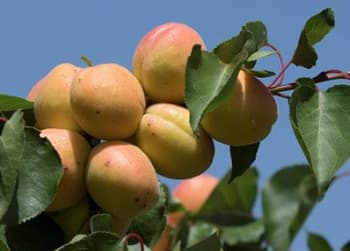 | 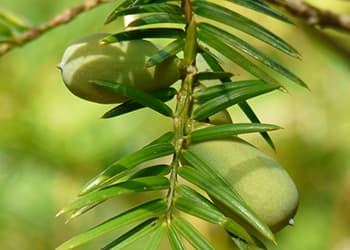 | |
| Size | Up to 66 ft tall | 20 to 40 ft | 50 to 80 ft |
| Leaves | Simple; glossy; lance-shaped; dark green; alternate | Bright green; ovate with pointed tips; erect | Green; stiff; needle-like; arranged spirally |
| Flowers | Dioecious; pale yellow to white; male flowers in a dense cluster; female flowers solitary or in three’s; inconspicuous | Self-pollinated; white; borne single or double at the node | Cones; male flowers line in the underside of the shoot; female flowers in 2 to 5 in a group |
| Stem/Trunk | Woody; grey-brown; with fissures; lateral branches in a whorled spiral arrangement | Woody; light to reddish brown; erect | Woody; conical and whorled branches |
| Scent | Distinctive pungent scent | Lush, sweet and bitter scent | Pungent sandalwood-like scent |
Warnings And Cautions
Nutmeg in food is safe even for pregnant and lactating women consumption. However, in large amounts, it can cause miscarriage and birth defects in babies and should be avoided in pregnancy.
Unnecessary intake in doses greater than food is toxic. It may worsen depression and cause severe headaches. It may also cause hallucination, vomiting, flushes, and panic.
Nut allergy does not apply to nutmeg, and the allergy is rare. However, when used topically, it may cause contact dermatitis. Ingesting it may also trigger allergic rhinitis and asthma. So, use nutmeg with general care and perform a patch test before using it entirely on the skin.
Nutmeg and mace may interact with medications, especially medicines for the liver. It may also hamper the effect of sedatives and depressants.
Before taking nutmeg or any medications, talk to your doctor to discuss potential benefits and side effects.
⇒ Similar to Morphine: The Best Natural Painkiller that Grows in Your Backyard








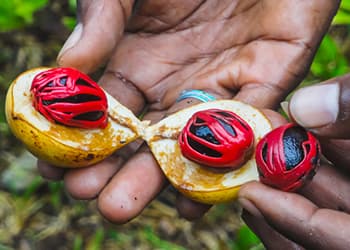
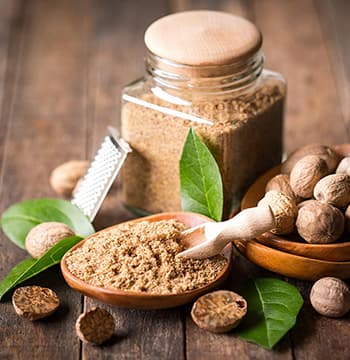 Nervous and sleep disorders
Nervous and sleep disorders
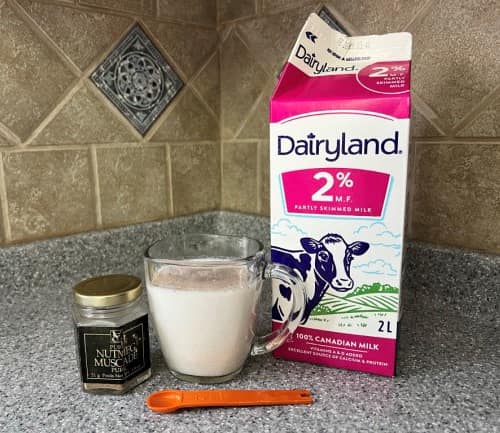




Post more home remedies
You left out anti-depressant. I’ve been on just about every anti-depressant and nutmeg does the same job without the unpleasant side effects.
That sounds fantastic. How do you use it for said effects and in what quantity and frequency of use?
How much and how often can I use nutmeg
How do you take it?
I wonder if microwaving any food or drink intended to create health might be counter productive ? A nutmeg tea nuked most certainly would be less effective than a stove heated one – just an observation and recommendation…
Grind is the present tense, ground, not grounded is the past tense.
Grounded means something entirely different.
Agreed… that stuck in my craw too!
Hi Pam,
Thank you so much for pointing this out!
The typo has now been corrected.
Many blessings and good health!
Thanks Language Police!
Although I have a degree in History, I now and for many years have wished that I would have studied Botany.